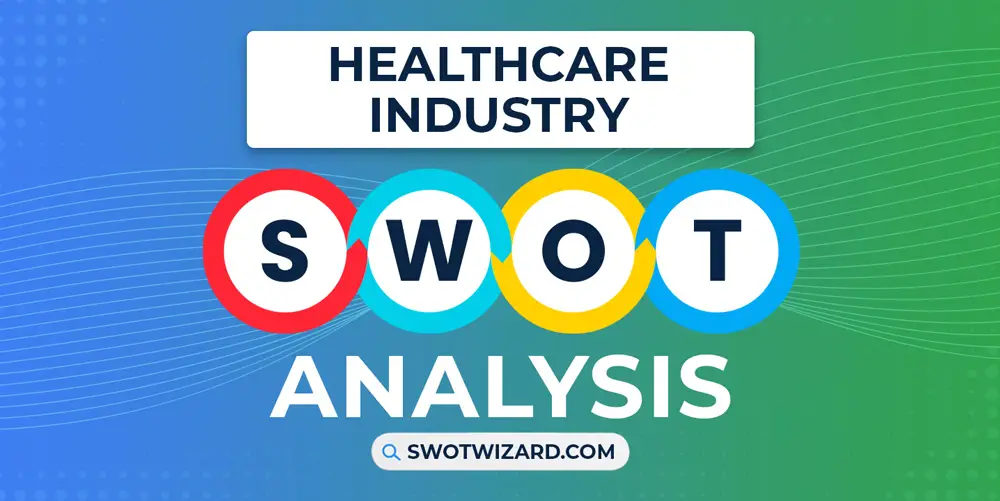Healthcare is in our everyday life, from an infant’s first heartbeat to their last breath. Whether it’s simple fever or cancer, we depend on this sector.
From the other perspective, the industry has undergone significant changes in every aspect and presented new opportunities with new strengths and tackling weaknesses and threats, which we will discuss in this healthcare industry swot analysis.
Healthcare Industry Overview
The healthcare industry has a rich history dating back to ancient civilizations like Egypt and Greece. After that time, there were great innovators, Ibn-Sina, and others who pushed the industry to grow.
The modern healthcare industry started in the last two hundred years. The industry has experienced rapid growth in the modern era, with global healthcare spending reaching $734 B in 2021. The sector employs over 100 million people worldwide, catering to millions of customers, and is expected to grow at 10.3% annually.
Despite this growth, access to healthcare remains limited in many parts of the world, with over 1 billion people lacking access to essential healthcare services.
Competitors in Healthcare Industry
CVS Health Corp. | UnitedHealth Group Inc. | McKesson Corp. | AmerisourceBergen Corp. | Cardinal Health Inc. | Cigna Corp. | Elevance Health | Centene Corp. | Walgreens Boots Alliance Inc. | Pfizer
Did You Know?
The average waiting time in the five major states is 24 days. That means by the time you meet the doctor, there will be 256,488 newborn babies in the USA.
Strengths – Healthcare Industry SWOT Analysis
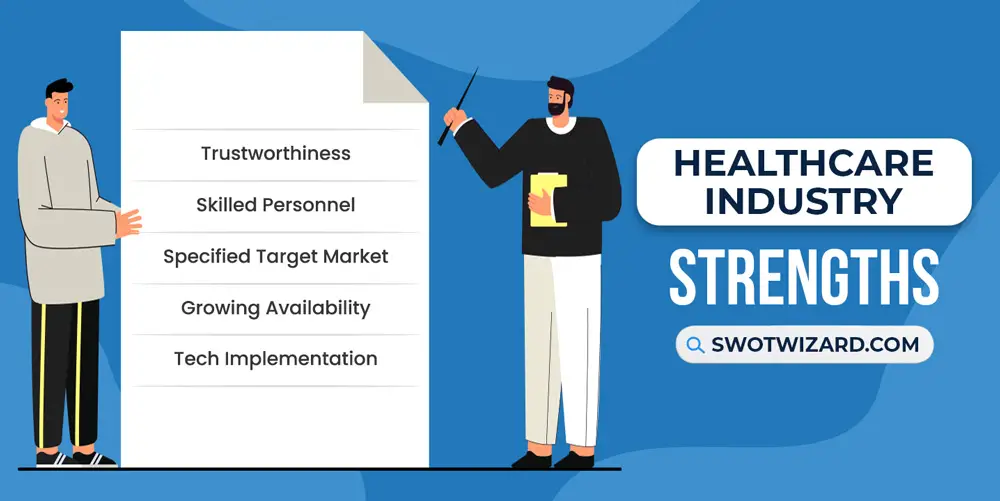
Trustworthiness: The entire industry is built upon trust among the service giver and takers and works as fuel to stabilize the market. A study shows that more than most American believe in the healthcare sector. Besides, globally the rate is increasing, and because of that, governments are incentivizing this sector.
Skilled Personnel: As sensitive as the healthcare industry can be, qualified personnel must be from the lower level to the upper. Currently, more than 22M people are working in the healthcare sector in the USA alone, and more than 80 M worldwide. And, as the market is growing rapidly, it will likely become one of the biggest industries in a few decades.
Specified Target Market: The entire healthcare sector is divided into different sectors, so that the industry can focus on the underserved sectors and provide opportunities for the personnel to develop their skills. As a result, doctors, nurses, and others can choose the path they want to pursue to serve that niche market.
Growing Availability: Even though a large chunk of the population doesn’t have the proper access to all the healthcare services they need, the situation is improving. As a result, we can see that developing and third-world countries have more healthcare infrastructure and availability of services.
Tech Implementation: The world is undergoing significant changes because of technology, and the healthcare industry has benefited greatly. Not only it automates lots of processes, but also it makes the work more clear to understand better and makes the process more efficient and effective. And it is paying off by people trusting more in the industry.
Weaknesses – Healthcare Industry SWOT Analysis
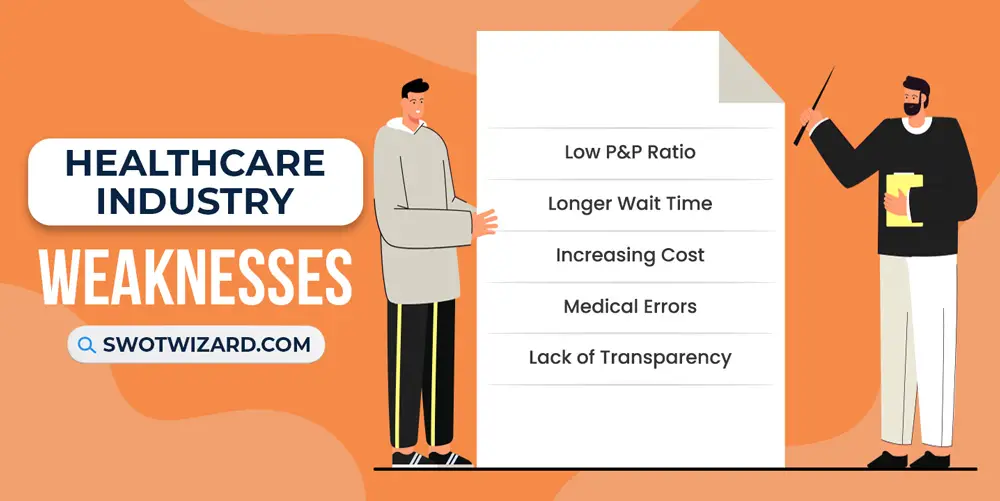
Low P&P Ratio: Most healthcare access and benefits are available in the first world and developed countries, and the scenario is exactly the opposite for third-world countries. In more than 20 countries, less than one doctor is available for one thousand people. And the availability ratio between doctors and patients globally stands at 16.67 for one thousand people, which is low.
Longer Wait Time: Because of the less availability of professionals, the service pressure is high, and waiting time is increasing. For complicated cases, there are some issues where it takes more than 25 days to get an appointment with a doctor, and in some cases, it can be three to four months, which can be frustrating and scary in emergencies.
Increasing Cost: The costs in every healthcare sector are growing, which include the aging population, disease prevalence, rising medicine prices, rising admin and service fees, etc. As a result, most people can’t access essential healthcare services; even with insurance, 71% can’t get the services they need.
Medical Errors: Medical errors can occur in any healthcare setting and have severe consequences for patients, lowering the system’s trustworthiness. And a study shows that around 10% of all deaths are because of this particular issue. As a result, it is constantly eroding patient trust in the healthcare system.
Lack of Transparency: One common issue people face when they go for treatments is vague billings, unclear statements, and lower transparency in the system. As a result, it makes it difficult for patients to make informed decisions about their care. Besides, it affects the overall system’s dependency and trust.
Opportunities – Healthcare Industry SWOT Analysis
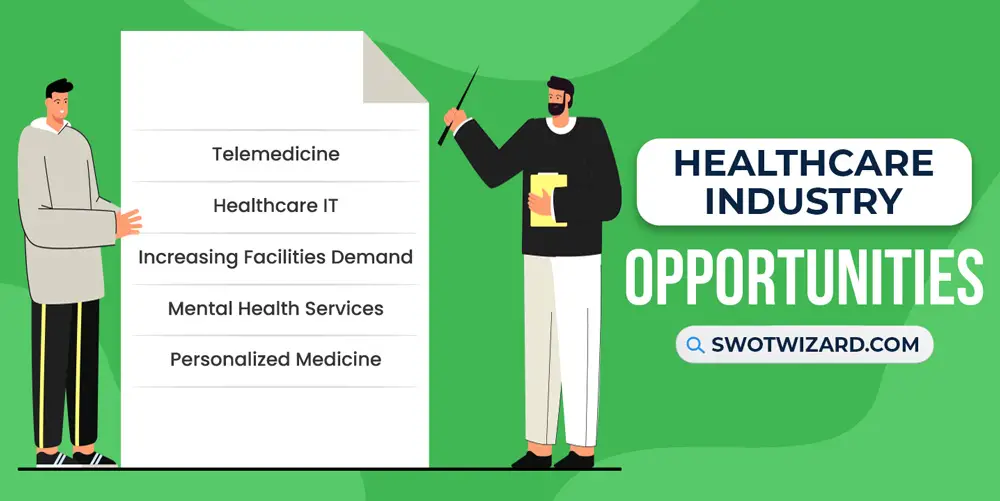
Telemedicine: With the increased use of technology, telemedicine has become a suitable option for patients who want to receive medical consultations from home. And as we already see in the data, the demand for telemedicine is growing through the roof, especially after covid. As a result, there is a growing demand for telemedicine services, and entrepreneurs can take advantage by creating better platforms.
Healthcare IT: Data is everything in this data, and the power of these can be instrumental in this sector. The demand for skilled IT professionals who can help manage electronic health records (EHRs), develop and maintain health information systems, and create new healthcare applications is rising. It is high time the industry looks at that.
Increasing Facilities Demand: By 2030, there will be 21% of people with more than 65 years, meaning they are in the aging phase, and globally the number will be 1.4 B people. As a result, there is a growing demand for long-term care facilities, assisted living facilities, and home health care services, and there is enough opportunity to cater to this market.
Mental Health Services: The depression rate has increased by 25% since the pandemic, and the global mental health suffering rate is 13%. And the growing demand for mental health services is a problem that needs more prominent and better solutions now than ever, and the health industry should focus on that.
Personalized Medicine: The personalized medicine market has been growing in the last few years, and the predicted growth rate is at 6.5% in this decade. Advances in genetics and data analytics are driving the development of personalized medicine is booming and almost mature to tap into the market.
Threats – Healthcare Industry SWOT Analysis
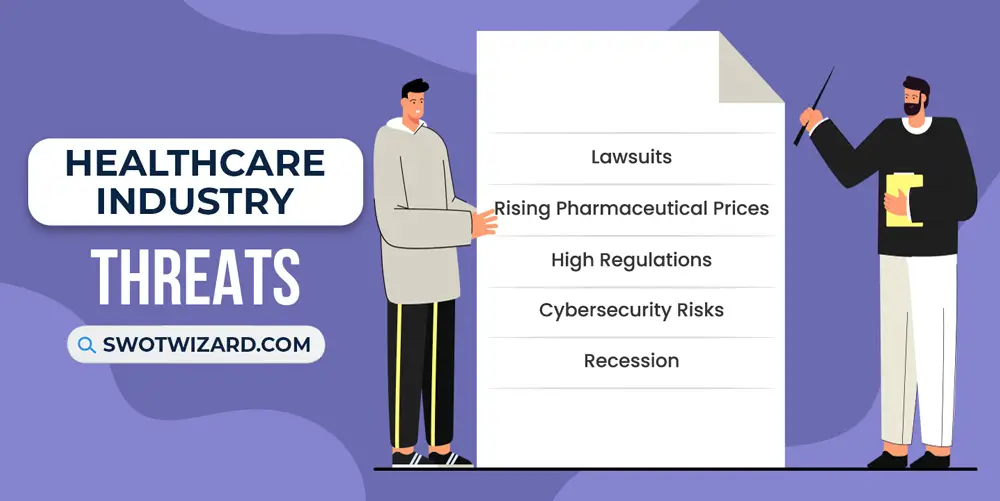
Lawsuits: It is nothing new, but healthcare providers are now facing more lawsuits, resulting in significant financial and reputational damage. In 2022, there have been too many lawsuits related to cases that total more than billions, not to mention the total amount in the last five years.
Rising Pharmaceutical Prices: After covid, the price of pharma products has been growing, and in some cases, it has increased by three hundred percent. As a result, it is getting increasingly difficult for people to access medication, not to mention the amount of capital and cost the companies have to bear, hurting the business.
High Regulations: With new health tech coming every year, new medicines, ways of surgery, and many other factors, it is getting more complex for the government and the entire industry to regulate the market correctly. As a result, some people are taking advantage of it, and some are getting out of the business.
Cybersecurity Risks: Complete healthcare services are being modernized, and as part of it, all the data, patient information, and personal information are stored digitally for better access and analysis. But, as time goes by, the industry is becoming vulnerable to cyberattacks, which can compromise patient data and disrupt operations.
Recession: Now that there is an upcoming recession, it is already starting to impact the healthcare industry, slowing down healthcare investments. Besides, the healthcare industry is already expensive enough for most people, and even with insurance, it will be more difficult.
[Bonus Infographic] SWOT Analysis of Healthcare Industry
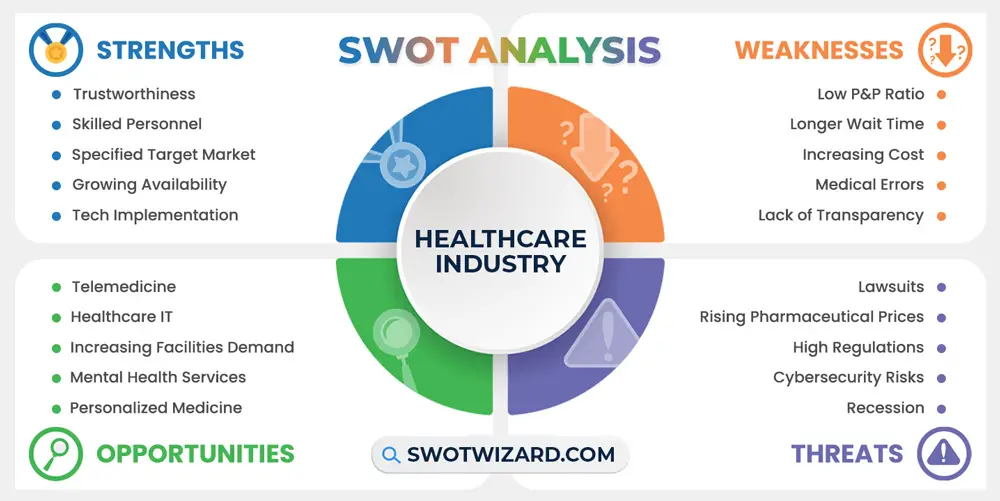
Recommendations for Healthcare Industry
In thousands of years of the healthcare industry’s history, it faces some unique issues that it must tackle and adapt to the environment. Here are some things they can do!
- Implementing innovative health tech will improve healthcare services, reduce costs, and enhance the patient experience.
- Embracing personalized medicine and genetic testing to provide more targeted treatments will create a new horizon in the industry.
- It is high time to increase investment in mental health services to meet growing demand.
- Adapting to changing consumer behavior by offering transparency, value-based pricing, and patient-centered care will increase customer trustworthiness and a positive reputation.
- Keeping up with changing government regulations and policies to avoid lawsuits and inconvenient circumstances.
Frequently Asked Questions (FAQs)
How Big is the Healthcare Industry in the USA?
The healthcare industry in the USA is more than $808 B, almost 20% of the USA GDP in 2022.
What is the World’s Largest Healthcare Company?
UnitedHealth Group Incorporated is the world's largest healthcare company, with $297.6 billion in revenue in 2022.
Final Words on Healthcare Industry SWOT Analysis
The healthcare industry is complex and dynamic and presents opportunities and challenges. The healthcare industry can stay competitive and deliver quality patient care by leveraging technology, embracing personalized medicine, increasing availability, targeting specific markets, addressing cybersecurity risks, and adapting to government regulations. However, they must also prepare for a recession, rising costs, lower waiting time and medical errors, lawsuits, and regulatory changes while addressing high prices and shortages of skilled professionals.
References
- Goold, S. D. (2002). Trust, distrust and trustworthiness. Journal of General Internal Medicine, 17(1), 79–81.
- Laughlin, L., Anderson, A., Martinez, A., & Gayfield, A. (2021, April 5). 22 Million Employed in Health Care Fight Against COVID-19. U.S. Census Bureau.
- Bader, S. (2017, June 27). India turns to the private sector to bring health care to underserved areas. Devex.
- Peters, D. H., Garg, A., Bloom, G., Walker, D. G., Brieger, W. R., & Rahman, M. M. (2008). Poverty and Access to Health Care in Developing Countries. Annals of the New York Academy of Sciences, 1136(1), 161–171.
- Morilla, M. J., Sans-Corrales, M., Casasa, A., & Giménez, N. (2017). Implementing technology in healthcare: insights from physicians. BMC Medical Informatics and Decision Making, 17(1).
- Wikipedia contributors. (n.d.). List of countries and dependencies by number of physicians. Wikipedia.
- Heath, S. (2022, September 15). Average Patient Appointment Wait Time Is 26 Days in 2022. PatientEngagementHIT.
- Ollove, M. (2022, October 7). Many Patients Can’t Afford Health Costs Even With Insurance. The Pew Charitable Trusts.
- Study Suggests Medical Errors Now Third Leading Cause of Death in the U.S. (2016, May 3). Johns Hopkins Medicine.
- Rosenthal, E. (2017, March 29). Those Indecipherable Medical Bills? They’re One Reason Health Care Costs So Much. The New York Times.
- Busso, M., González, M. J. G., & Scartascini, C. (2021). On the Demand for Telemedicine: Evidence from the Covid-19 Pandemic. RePEc: Research Papers in Economics.
- Demand for healthcare IT professionals at an all-time high: Report. (2022, April 23). The Hindu Business Line.
- Ageing and health. (2022, October 1). WHO.
- Mental health. (n.d.). WHO.
- Personalized Medicine Market. (n.d.). Future Market Insights.
- Ten of the Largest Medical Malpractice Verdicts of 2022. (2023, January 17). JD Supra.
- Sullivan, K. (2022, June 7). Prices of new drugs have soared. Will legislation be able to stop it? NBC News.
- Field, R. I. (2008). Why Is Health Care Regulation So Complex? PubMed Central (PMC).
- Powell, O. (2023, March 2). Why healthcare providers are focusing on cyber resilience. Cyber Security Hub.
- Balasubramanian, S., MD JD. (2023, February 28). Healthcare Investments Are Slowing Down. Forbes.

